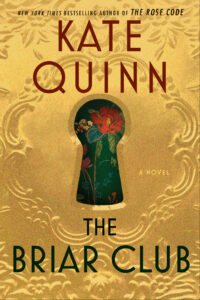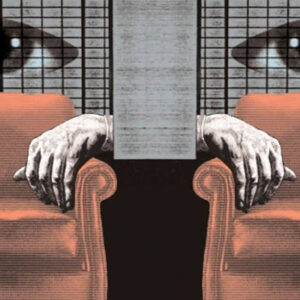I was drinking mojitos after a Florida literary festival with several other authors—it’s a time-honored tradition, the post-panel drink shared with fellow scribes once all the speeches and Q&A are done—when I heard a historical tidbit that made my jaw drop. Did I know that in the 1950s, the US Army hosted a massive war game where they simulated a Soviet invasion, occupation, and then liberation of a small town in Texas?
No, I did not. In fact I was certain, when I first heard this, that I was being taken for a ride.
“Nope,” replied Adrianna Cuevas, the lovely and award-winning author of middle-grade novels The Ghosts of Rancho Espanto and The Total Eclipse of Nestor Lopez. “Operation Longhorn—I’ll send you some articles; it’s wild.”
She did, and immediately made it into the acknowledgments page of my novel The Briar Club which had its entire third act restructured because of this one wacky fact. The US Army really did run a practice drill for a Soviet invasion on the town of Lampasas, Texas, and it goes to show you that truth really is stranger than anything that springs from the brain of a novelist.
Nowadays whenever I read something truly off-the-wall in a historical novel, I think to myself “I bet that really happened, because nobody would make that up.” Novelists, after all, are restricted by what is plausible: will a reader believe this could really happen? Reality knows no such constraints: anything can happen, and usually already has.
The broad spotlight of history, and thus the pages of the history books, tend to focus on the rulers of nations and winners of wars (and, let’s be honest, mostly white European males). That doesn’t mean that plenty of interesting historical events haven’t centered around other demographics of the population, and that’s where history gets interesting. Digging around the edges of the historical record, looking for the lesser-known stories—that’s where I love to play, and it’s where I find most of the ideas for my books.
“What were the ladies up to?” That’s the question I ask myself whenever I look at any historical event or period that interests me, given my particular interest in lesser-known women of the past. “How did the ladies contribute?” Because if there’s anything I’ve learned, it’s that women are almost always involved in any historical event you can think of…and they are frequently doing something more interesting than you might have assumed.
Finding their stories isn’t as hard as you might think—you just need to keep an eye out for the throwaway tidbit in a tidal wave of information, and then be willing to chase it. One tiny line in a massive volume about the WWII Soviet Air Force—an all-female regiment of pilots, what was this now?—led me straight into a 2am Googling frenzy where I found the legendary ladies known as the Night Witches, and eventually the plot of my book The Huntress. Musing “How did women contribute in the World War I war effort besides fundraising and nursing?” turned up a book quite literally called Women Heroes of WWI by Kathryn Atwood, where I learned that women of the Great War had not only served as fundraisers and nurses, but as guides, doctors, soldiers, journalists, and spies…and a spark from that book eventually became The Alice Network. Reading about the codebreakers of Bletchley Park and learning that of the 8,988 people employed at its peak, 6,757 of the were women—and then observing that most of the stories being told about the codebreakers involved the men—made me wonder “Well, what about all those women?” I started digging into the few names that were mentioned (Joan Clarke, Mavis Leger) and that led me to all the other ladies both named and nameless who inspired The Rose Code.
I keep a permanent file on my laptop of random historical facts I’ve dug up over the years, which I hope will someday make it into a novel. Who knows if I’ll ever write about that mysterious 1920s death on a remote Scottish island, or the Renaissance tomb in the Vatican found mysteriously empty of the woman who was supposed to be buried in it, or the 19th century woman who helmed a ship when her sea-captain husband took sick? Maybe, maybe not. But the factoids I stored in that file about the WWII women’s baseball leagues, the woman who worked for the National Archives in D.C. yet was involved in organized crime, and the disappearance of Gustav Klimt’s Faculty paintings after a Nazi bonfire in the courtyard of an Austrian castle? Those all made it into The Briar Club.
Keep your eye out for the interesting nuggets buried in history books, for the throwaway lines that make you sit up and want to know more. Follow those lines wherever they lead—down the back pages of an easy Google search, through countless digitized paragraphs in Newspapers.com, through the dustiest shelves of library books and all those small-press/indie-published books put on sale by history nerds for a niche audience. Follow scholars, podcasters, bloggers, and websites dedicated to promoting interesting little-known people and stories from the past (I love “A Mighty Girl,” which promotes lesser-known women of times gone by with huge enthusiasm). And the more you look the more you’ll find, because one interesting discovery tends to lead to another: reading about the Night Witches meant I learned about even more Soviet women soldiers of World War II…including sniper extraordinaire Lyudmila Pavlichenko, the larger-than-life “Lady Death” who became the heroine of The Diamond Eye. After a while it feels like these tidbits are finding you, just waiting to tap you on the shoulder.
All you have to do is listen—to the footnotes in the text, the random article on your feed, to the writer you just met over a mojito on a hot Florida night—and then be willing to go down that rabbit hole.
***


















